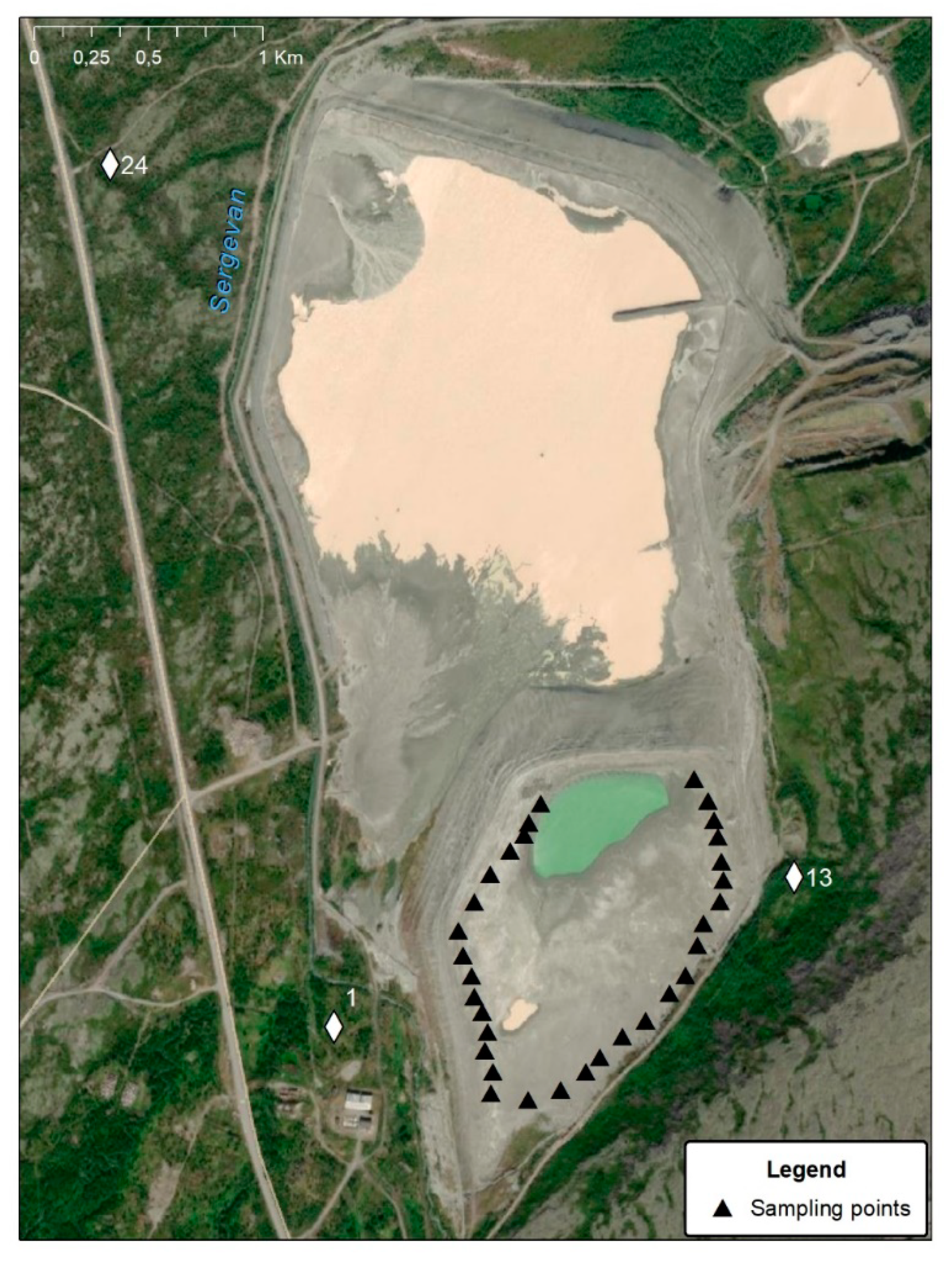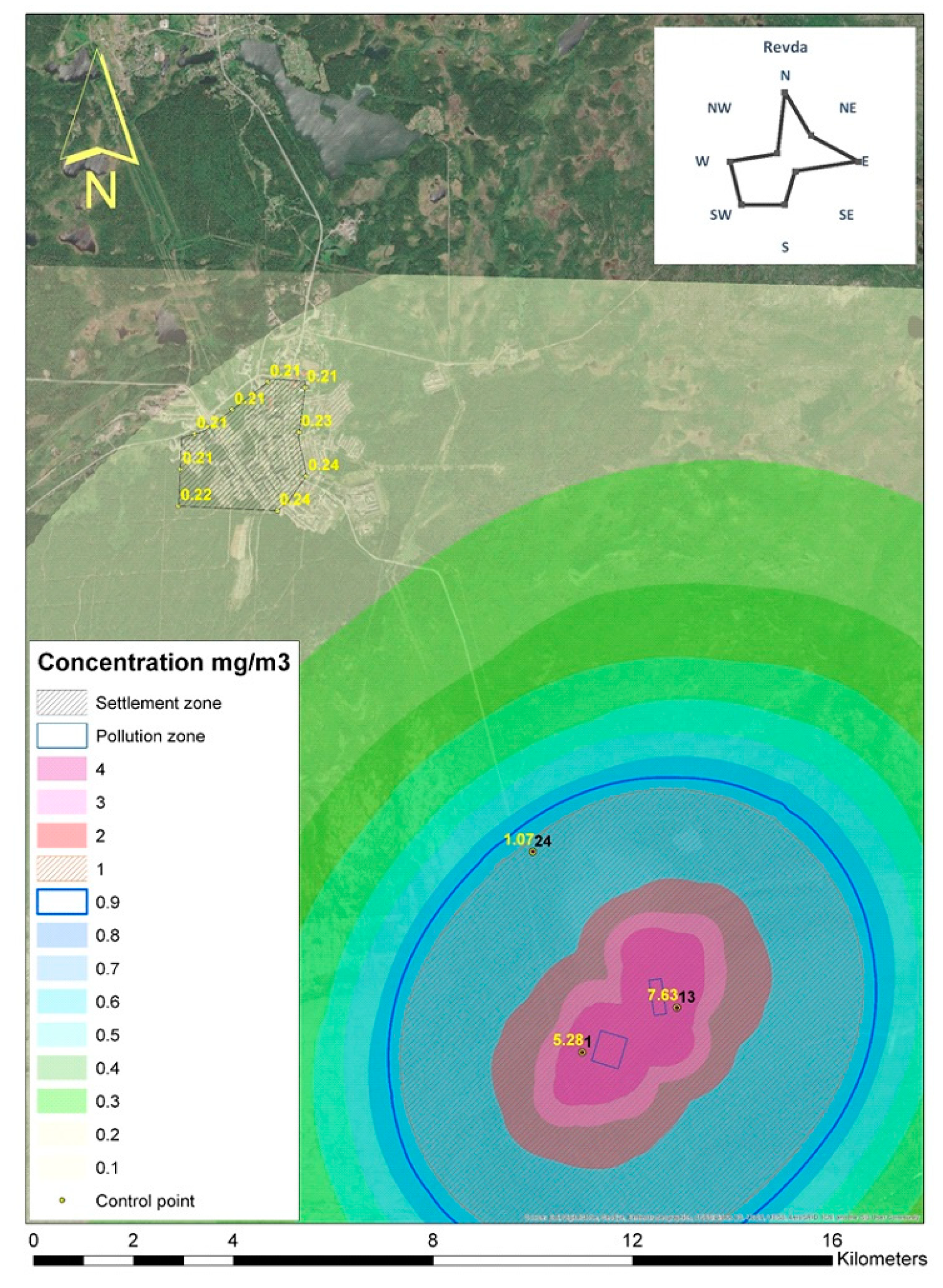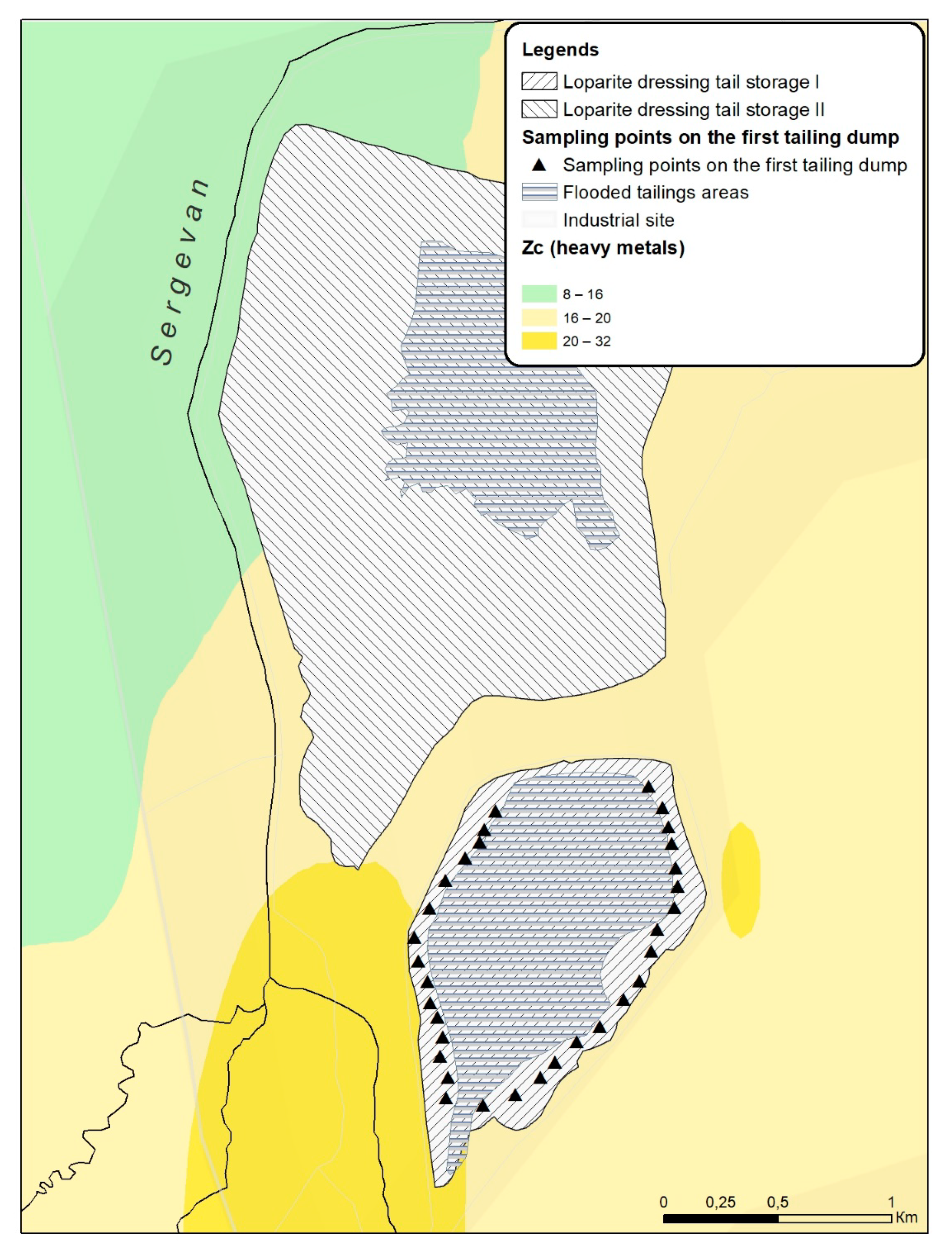Modelling of the Chemical Halo of Dust Pollution Migration in Loparite Ore Tailings Storage Facilities
Abstract
:1. Introduction
2. Materials and Methods
- (1)
- low wind load, at which the wind speed does not exceed 5 m/s;
- (2)
- normal meteorological conditions under which the wind speed does not exceed 8 m/s;
- (3)
- unfavorable meteorological conditions under which the wind speed exceeds 10 m/s.
3. Results and Discussion
- Concentration tailings: Mn > Sr > Ce > La > Nd > Pr > Sm
- Location 1: Mn > Sr > Ce > La > Nd > Pr > Sm
- Location 13: Mn > Sr > Ce > Nd > La > Pr > Sm
- Location 24: Mn > Sr > Ce > La > Nd > Pr > Sm
4. Conclusions
Author Contributions
Funding
Data Availability Statement
Acknowledgments
Conflicts of Interest
References
- Edahbi, M.; Plante, B.; Benzaazoua, M. Environmental challenges and identification of the knowledge gaps associated with REE mine wastes management. J. Clean. Prod. 2019, 212, 1232–1241. [Google Scholar] [CrossRef]
- Buikema, N.; Zwissler, B.; Seagren, E.; Oommen, T.; Vitton, S. Stabilisation of iron mine tailings through biocalcification. Environ. Geotech. 2018, 5, 94–106. [Google Scholar] [CrossRef]
- Loredo, J.; Soto, J.; Álvarez, R.; Ordóñez, A. Atmospheric Monitoring at Abandoned Mercury Mine Sites in Asturias (NW Spain). Environ. Monit. Assess. 2006, 130, 201–214. [Google Scholar] [CrossRef] [PubMed]
- Corriveau, M.; Jamieson, H.; Parsons, M.; Campbell, J.; Lanzirotti, A. Direct characterization of airborne particles associated with arsenic-rich mine tailings: Particle size, mineralogy and texture. Appl. Geochem. 2011, 26, 1639–1648. [Google Scholar] [CrossRef]
- Lilic, N.; Cvjetic, A.; Knezevic, D.; Milisavljevic, V.; Pantelic, U. Dust and noise environmental impact assessment and control in Serbian mining practice. Minerals 2018, 8, 34. [Google Scholar] [CrossRef] [Green Version]
- Stovern, M.; Guzmán, H.; Rine, K.; Felix, O.; King, M.; Ela, W.; Betterton, E.; Sáez, A. Windblown Dust Deposition Forecasting and Spread of Contamination around Mine Tailings. Atmosphere 2016, 7, 16. [Google Scholar] [CrossRef] [PubMed] [Green Version]
- Castillo, S.; Alastuey, A.; Cuevas, E.; Querol, X.; Avila, A. Quantifying Dry and Wet Deposition Fluxes in Two Regions of Contrasting African Influence: The NE Iberian Peninsula and the Canary Islands. Atmosphere 2017, 8, 86. [Google Scholar] [CrossRef] [Green Version]
- Keresztesi, Á.; Birsan, M.; Nita, I.; Bodor, Z.; Szép, R. Assessing the neutralisation, wet deposition and source contributions of the precipitation chemistry over Europe during 2000–2017. Environ. Sci. Eur. 2019, 31, 50. [Google Scholar] [CrossRef] [Green Version]
- Szép, R.; Mateescu, E.; Niță, I.; Birsan, M.; Bodor, Z.; Keresztesi, Á. Effects of the Eastern Carpathians on atmospheric circulations and precipitation chemistry from 2006 to 2016 at four monitoring stations (Eastern Carpathians, Romania). Atmos. Res. 2018, 214, 311–328. [Google Scholar] [CrossRef]
- Bodor, Z.; Bodor, K.; Keresztesi, Á.; Szép, R. Major air pollutants seasonal variation analysis and long-range transport of PM10 in an urban environment with specific climate condition in Transylvania (Romania). Environ. Sci. Pollut. Res. 2020, 27, 38181–38199. [Google Scholar] [CrossRef]
- Gašparac, G.; Jeričević, A.; Kumar, P.; Grisogono, B. Regional-scale modelling for the assessment of atmospheric particulate matter concentrations at rural background locations in Europe. Atmos. Chem. Phys. 2020, 20, 6395–6415. [Google Scholar] [CrossRef]
- Wang, J.; Xie, X.; Fang, C. Temporal and Spatial Distribution Characteristics of Atmospheric Particulate Matter (PM10 and PM2.5) in Changchun and Analysis of Its Influencing Factors. Atmosphere 2019, 10, 651. [Google Scholar] [CrossRef] [Green Version]
- Tu, X.; Lu, Y.; Yao, R.; Zhu, J. Air Quality in Ningbo and Transport Trajectory Characteristics of Primary Pollutants in Autumn and Winter. Atmosphere 2019, 10, 120. [Google Scholar] [CrossRef] [Green Version]
- Muhammad, F.K.; Naila, Y.; Farrukh, C.; Imran, S. Temporal variability and characterization of aerosols across the Pakistan region during the winter fog periods. Atmosphere 2016, 7, 67. [Google Scholar] [CrossRef] [Green Version]
- Yang, W.; Wang, G.; Bi, C. Analysis of Long-Range Transport Effects on PM2.5 during a Short Severe Haze in Beijing, China. Aerosol Air Qual. Res. 2017, 17, 1610–1622. [Google Scholar] [CrossRef]
- Wu, D.; Zhang, F.; Ge, X.; Yang, M.; Xia, J.; Liu, G.; Li, F. Chemical and Light Extinction Characteristics of Atmospheric Aerosols in Suburban Nanjing, China. Atmosphere 2017, 8, 149. [Google Scholar] [CrossRef] [Green Version]
- Cao, L.M.; Zhou, Y.; Zhang, Z.; Sun, W.W.; Mu, G.; Chen, W.H. Impacts of airborne particulate matter and its components on respiratory system health. Chin. J. Prev. Med. 2016, 50, 1114–1118. [Google Scholar]
- Krewski, D.; Jerrett, M.; Burnett, R.T.; Ma, R.; Hughes, E.; Shi, Y.; Turner, M.C.; Thurston, G.; Calle, E.E.; Thun, M.J.; et al. Extended follow-up and spatial analysis of the American Cancer Society study linking particulate air pollution and mortality. Res. Rep. Health Eff. Inst. 2009, 140, 5–114, discussion 115–136. [Google Scholar]
- Mehta, U.; Dey, S.; Chowdhury, S.; Ghosh, S.; Hart, J.; Kurpad, A. The Association Between Ambient PM2.5 Exposure and Anemia Outcomes Among Children Under Five Years of Age in India. Environ. Epidemiol. 2021, 5, e125. [Google Scholar] [CrossRef] [PubMed]
- Brook, R.; Rajagopalan, S.; Pope, C.; Brook, J.; Bhatnagar, A.; Diez-Roux, A.; Holguin, F.; Hong, Y.; Luepker, R.; Mittleman, M.; et al. Particulate Matter Air Pollution and Cardiovascular Disease. Circulation 2010, 121, 2331–2378. [Google Scholar] [CrossRef] [PubMed] [Green Version]
- Thompson, J. Airborne Particulate Matter. J. Occup. Environ. Med. 2018, 60, 392–423. [Google Scholar] [CrossRef]
- Huang, X.; Deng, H.; Zheng, C.; Cao, G. Hydrogeochemical signatures and evolution of groundwater impacted by the Bayan Obo tailing pond in northwest China. Sci. Total Environ. 2016, 543, 357–372. [Google Scholar] [CrossRef]
- Schreiber, A.; Marx, J.; Zapp, P.; Hake, J.; Voßenkaul, D.; Friedrich, B. Environmental Impacts of Rare Earth Mining and Separation Based on Eudialyte: A New European Way. Resources 2016, 5, 32. [Google Scholar] [CrossRef] [Green Version]
- Cánovas, C.; Basallote, M.; Macías, F. Distribution and availability of rare earth elements and trace elements in the estuarine waters of the Ría of Huelva (SW Spain). Environ. Pollut. 2020, 267, 115506. [Google Scholar] [CrossRef]
- Tang, S.; Zheng, C.; Chen, M.; Du, W.; Xu, X. Geobiochemistry characteristics of rare earth elements in soil and ground water: A case study in Baotou, China. Sci. Rep. 2020, 10, 11740. [Google Scholar] [CrossRef]
- Antonina, A.; Shazili, N.; Kamaruzzaman, B.; Ong, M.; Rosnan, Y.; Sharifah, F. Geochemistry of the Rare Earth Elements (REE) Distribution in Terengganu Coastal Waters: A Study Case from Redang Island Marine Sediment. Open J. Mar. Sci. 2013, 03, 154–159. [Google Scholar] [CrossRef] [Green Version]
- Fabijańczyk, P.; Zawadzki, J. Complementary Use of Magnetometric Measurements for Geochemical Investigation of Light REE Concentration in Anthropogenically Polluted Soils. Minerals 2021, 11, 457. [Google Scholar] [CrossRef]
- Zhou, J.; Wang, X.; Nie, L.; McKinley, J.; Liu, H.; Zhang, B.; Han, Z. Geochemical background and dispersion pattern of the world’s largest REE deposit of Bayan Obo, China. J. Geochem. Explor. 2020, 215, 106545. [Google Scholar] [CrossRef]
- Ferreira, M.; Fontes, M.; Bellato, C.; Marques Neto, J.; Lima, H.; Fendorf, S. Geochemical signatures and natural background values of rare earth elements in soils of Brazilian Amazon. Environ. Pollut. 2021, 277, 116743. [Google Scholar] [CrossRef] [PubMed]
- Barbieri, M.; Andrei, F.; Nigro, A.; Vitale, S.; Sappa, G. The relationship between the concentration of rare earth elements in landfill soil and their distribution in the parent material: A case study from Cerreto, Roccasecca, Central Italy. J. Geochem. Explor. 2020, 213, 106492. [Google Scholar] [CrossRef]
- Aghnatios, C.; Losno, R.; Dulac, F. A fine fraction of soil used as an aerosol analogue during the DUNE experiment: Sequential solubility in water, decreasing pH step-by-step. Biogeosciences 2014, 11, 4627–4633. [Google Scholar] [CrossRef]
- Suresh, K.; Singh, U.; Kumar, A.; Karri, D.; Peketi, A.; Ramaswamy, V. Provenance tracing of long-range transported dust over the Northeastern Arabian Sea during the southwest monsoon. Atmos. Res. 2021, 250, 105377. [Google Scholar] [CrossRef]
- Tang, Y.; Han, G. Investigation of sources of atmospheric dust in Guiyang City, southwest China using rare earth element patterns. J. Earth Syst. Sci. 2019, 129, 18. [Google Scholar] [CrossRef]
- Gaberšek, M.; Gosar, M. Meltwater chemistry and characteristics of particulate matter deposited in snow as indicators of anthropogenic influences in an urban area. Environ. Geochem. Health 2020, 43, 2583–2595. [Google Scholar] [CrossRef] [PubMed]
- Zhou, H.; Chun, X.; Lü, C.; He, J.; Du, D. Geochemical characteristics of rare earth elements in windowsill dust in Baotou, China: Influence of the smelting industry on levels and composition. Environ. Sci. Process. Impacts 2020, 22, 2398–2405. [Google Scholar] [CrossRef] [PubMed]
- Stovern, M.; Felix, O.; Csavina, J.; Rine, K.; Russell, M.; Jones, R.; King, M.; Betterton, E.; Sáez, A. Simulation of windblown dust transport from a mine tailings impoundment using a computational fluid dynamics model. Aeolian Res. 2014, 14, 75–83. [Google Scholar] [CrossRef] [Green Version]
- Holmes, N.; Morawska, L. A review of dispersion modelling and its application to the dispersion of particles: An overview of different dispersion models available. Atmos. Environ. 2006, 40, 5902–5928. [Google Scholar] [CrossRef] [Green Version]
- Schulz, D.; Schwindt, N.; Schmidt, E.; Jasevičius, R.; Kruggel-Emden, H. Investigation of the dust release from bulk material undergoing various mechanical processes using a coupled DEM/CFD approach. Powder Technol. 2019, 355, 37–56. [Google Scholar] [CrossRef]
- Kontos, S.; Kakosimos, K.; Liora, N.; Poupkou, A.; Melas, D. Towards a regional dust modeling system in the central Middle East: Evaluation, uncertainties and recommendations. Atmos. Environ. 2021, 246, 118160. [Google Scholar] [CrossRef]
- Baklanov, A.; Rigina, O. Environmental modeling of dusting from the mining and concentration sites in the Kola Peninsula, Northwest Russia. In The XI World Clear Air and Environment Congress; IUAPPA-NACA: Durban, South Africa, 1998; Volume 1, 4F-3, pp. 1–18. [Google Scholar]
- Baklanov, A. Numerical Modeling in Mine Aerology; Kola branch of the USSR Academy of Sciences: Apatity, Russia, 1988; 200p. (In Russian) [Google Scholar]
- Amosov, P.V.; Baklanov, A.A.; Masloboev, V.A.; Mazuhkina, S.I. CFD-model development of dust transfer at a tailings dump. In Proceedings of the 4th International Conference on Hazardous and Industrial Waste Management—CRETE-2014, Chania, Greece, 2–5 September 2014; Sessions s25/5. Technical University of Crete: Chania, Greece, 2014; p. 9. [Google Scholar]
- Amosov, P.V.; Baklanov, A.A. Estimation of the vertical flow of dust mass at the tailing dump based on the DEAD scheme. Probl. Subsurf. Use 2015, 3, 80–85. (In Russian) [Google Scholar]
- Westphal, D.; Toon, O.; Carlson, T. A Case Study of Mobilization and Transport of Saharan Dust. J. Atmos. Sci. 1988, 45, 2145–2175. [Google Scholar] [CrossRef] [Green Version]
- Amosov, P.; Baklanov, A.; Makarov, D.; Masloboev, V. Estimating air pollution levels by numerical simulation depending on wind flow speed and dust source area. Izv. Vyss. uchebnykh Zaved. Gorn. zhurnal 2020, 80–89. (In Russian) [Google Scholar] [CrossRef]
- Guidelines on the Calculation, Regulation and Control of Polluting Emissions into the Atmospheric Air. Russian Scientific Research Institute of Atmospheric Air Protection (SRI-Atmosphere), St. Petersburg. 2012. Available online: https://files.stroyinf.ru/Data1/46/46202/index.htm (accessed on 29 September 2021). (In Russian).
- Order of the Government of the Russian Federation No. 1316-r. On Approving the List of Pollutants, Which Are Subject to State Regulation Measures in the Field of Environmental Protection. Available online: https://docs.cntd.ru/document/420286994 (accessed on 10 May 2019). (In Russian).
- Order No. 273. On Approval of Methods for Calculating the Dispersion of Emissions of Harmful (Polluting) Substances in the Air. Ministry of Natural Resources and Environment of the Russian Federation, Moscow. 2017. Available online: https://cdnimg.rg.ru/pril/143/84/68/47734.pdf (accessed on 29 September 2021). (In Russian).
- Tverdov, A.A. Rare metals of the Lovozero massif. Rare Earths Mag. 2016, 3, 164–169. (In Russian) [Google Scholar]
- Krasavtseva, E.; Maksimova, V.; Makarov, D. Conditions affecting the release of heavy and rare earth metals from the mine tailings Kola Subarctic. Toxics 2021, 9, 163. [Google Scholar] [CrossRef] [PubMed]
- Kabata-Pendias, A. Trace Elements in Soils and Plants; CRC Press: Boca Raton, FL, USA, 2011; 548p. [Google Scholar]
- Nikonov, V.V.; Lukina, N.V.; Bezel’, V.S.; Bel’sky, E.A.; Bespalov, A.Y.; Golovchenko, A.V.; Dobrovol’skaya, T.G.; Dobrovol’sky, V.V.; Zukert, N.V.; Isaeva, L.G.; et al. Kola Science Centre Scattered Elements in Boreal Forests; Nauka: Moscow, Russia, 2004; 616p. (In Russian) [Google Scholar]
- Vinogradov, A. Average contents of chemical elements in the main types of igneous rocks of the earth’s crust. Geochemistry 1962, 7, 555–571. (In Russian) [Google Scholar]
- Sakan, S.M.; Djordjevi, D.S.; Manojovic, D.D.; Plic, P.S. Assessment of heavy metal pollutants accumulation in the Tisza river sediments. J. Environ. Manag. 2009, 90, 3382–3390. [Google Scholar] [CrossRef] [PubMed]
- Order of the State Committee for Ecology of Russia. Methodology for Calculating Harmful Emissions (Discharges) for a Complex of Equipment for Open Pit Mining (Based on Specific Indicators). Ministry of Fuel and Energy of the Russian Federation, Lyubertsy. 1999. Available online: http://gost.donses.ru/Data1/59/59758/index.htm (accessed on 29 September 2021). (In Russian).
- Methodological Guide for Calculating Emissions from Fugitive Sources in the Building Materials Industry; ZAO Nipiotstrom: Novorossiysk, Russia, 2000; 28p. (In Russian)
- World Weather. Available online: https://rp5.ru/ (accessed on 29 September 2021). (In Russian).
- Goryachev, A.A.; Laschuk, V.V.; Krasavtseva, E.A.; Alfertyev, N.L.; Makarov, D.V. Geoecological assessment of the current state of tailing dumps of different ages at the Karnasurt mine. Proc. Fersman Sci. Sess. GI KSC RAS 2020, 17, 128–132. (In Russian) [Google Scholar] [CrossRef]
- Resolution of the Chief State Sanitary Doctor of the Russian Federation. Sanitary Regulations and Norms No. 1.2.3685-21. Sanitary and Epidemiological Requirements for the Maintenance of Urban and Rural Areas, for Water Bodies, Drinking Water and Drinking Water Supply, Atmospheric Air, Soils, Living Quarters, Operation of Industrial, Public Premises, Organizations and the Implementation of Sanitary and Anti-Epidemic (Preventive) Measures. 2021. Available online: https://docs.cntd.ru/document/573536177?marker=7DI0K8 (accessed on 29 September 2021). (In Russian).
- Resolution of the Chief State Sanitary Doctor of the Russian Federation. Sanitary Regulations and Norms No. 2.2.1/2.1.1.1200-03. Sanitary Protection Zones and Sanitary Classification Enterprises, Structures and Other Objects. 2008. Available online: https://docs.cntd.ru/document/902065388?section=text (accessed on 29 September 2021). (In Russian).
- Order of the Ministry of Natural Resources of Russia (Ministry of Natural Resources and Environment of the Russian Federation) No. 536. On Approval of the Criteria for Classifying Waste as I-V hazard Classes in Terms of the Degree of Negative Impact on the Environment. 2015. Available online: https://docs.cntd.ru/document/420240163?section=text (accessed on 29 September 2021). (In Russian).
- Serdyutskaya, L.F. Technogenic ecology. Mathematical and Cartographic Modeling; URSS: Moscow, Russian, 2009; 226p. (In Russian) [Google Scholar]
- Krasavtseva, E.A.; Maksimova, V.V.; Gorbacheva, T.T.; Makarov, D.V.; Alfertyev, N.L. Evaluation of soils and plants chemical pollution within the area affected by storages of loparite ore processing waste. Mine Surv. Subsurf. Use 2021, 112, 52–58. (In Russian) [Google Scholar]
- Ahmadipour, F.; Bahramifar, N.; Mahmood Ghasempouri, S. Fractionation and mobility of cadmium and lead in soils of Amol area in Iran, using the modified BCR sequential extraction method. Chem. Speciat. Bioavailab. 2014, 26, 31–36. [Google Scholar] [CrossRef]
- Qin, F.; Wei, C.; Zhong, S.; Huang, X.; Pang, W.; Jiang, X. Soil heavy metal(loid)s and risk assessment in vicinity of a coal mining area from southwest Guizhou, China. J. Cent. South Univ. 2016, 23, 2205–2213. [Google Scholar] [CrossRef]
- Kowalska, J.; Mazurek, R.; Gąsiorek, M.; Setlak, M.; Zaleski, T.; Waroszewski, J. Soil pollution indices conditioned by medieval metallurgical activity—A case study from Krakow (Poland). Environ. Pollut. 2016, 218, 1023–1036. [Google Scholar] [CrossRef] [PubMed]
- Baran, A.; Antonkiewicz, J. Phytotoxicity and extractability of heavy metals from industrial wastes. Environ. Prot. Eng. 2017, 43, 143–155. [Google Scholar] [CrossRef]
- Wieczorek, J.; Baran, A.; Urbański, K.; Mazurek, R.; Klimowicz-Pawlas, A. Assessment of the pollution and ecological risk of lead and cadmium in soils. Environ. Geochem. Health 2018, 40, 2325–2342. [Google Scholar] [CrossRef] [PubMed]
- Wang, L.; Liang, T. Geochemical fractions of rare earth elements in soil around a mine tailing in Baotou. China Sci. Rep. 2015, 5, 12483. [Google Scholar] [CrossRef] [Green Version]
- Wang, L.; Liang, T. Anomalous abundance and redistribution patterns of rare earth elements in soils of a mining area in Inner Mongolia, China. Environ. Sci. Pollut. Res. 2016, 23, 11330–11338. [Google Scholar] [CrossRef] [PubMed]










| EFi Value | Enrichment Level |
|---|---|
| <1 | no enrichment |
| 1–3 | minor enrichment |
| 3–5 | moderate enrichment |
| 5–10 | moderately severe enrichment |
| 10–25 | severe enrichment |
| 25–50 | very severe enrichment |
| >50 | extremely severe enrichment |
| Element | Contain, mg/kg | Element | Contain, % |
|---|---|---|---|
| Cu | 5.36 ± 0.46 | Nb | 0.09 ± 0.01 |
| Zn | 171 ± 15.68 | Mn | 0.01 ± 0.001 |
| La | 160 ± 10.74 | Al | 7.86 ± 0.08 |
| Pr | 33.9 ± 4.02 | Fe | 3.00 ± 0.02 |
| Nd | 106 ± 9.65 | Zr | 0.21 ± 0.02 |
| Th | 16.5 ± 1.75 | Sr | 0.09 ± 0.01 |
| Ta | 75 ± 2.64 | Ce | 0.09 ± 0.01 |
Publisher’s Note: MDPI stays neutral with regard to jurisdictional claims in published maps and institutional affiliations. |
© 2021 by the authors. Licensee MDPI, Basel, Switzerland. This article is an open access article distributed under the terms and conditions of the Creative Commons Attribution (CC BY) license (https://creativecommons.org/licenses/by/4.0/).
Share and Cite
Krasavtseva, E.; Maksimova, V.; Makarov, D.; Potorochin, E. Modelling of the Chemical Halo of Dust Pollution Migration in Loparite Ore Tailings Storage Facilities. Minerals 2021, 11, 1077. https://doi.org/10.3390/min11101077
Krasavtseva E, Maksimova V, Makarov D, Potorochin E. Modelling of the Chemical Halo of Dust Pollution Migration in Loparite Ore Tailings Storage Facilities. Minerals. 2021; 11(10):1077. https://doi.org/10.3390/min11101077
Chicago/Turabian StyleKrasavtseva, Eugenia, Victoria Maksimova, Dmitriy Makarov, and Eugeniy Potorochin. 2021. "Modelling of the Chemical Halo of Dust Pollution Migration in Loparite Ore Tailings Storage Facilities" Minerals 11, no. 10: 1077. https://doi.org/10.3390/min11101077






